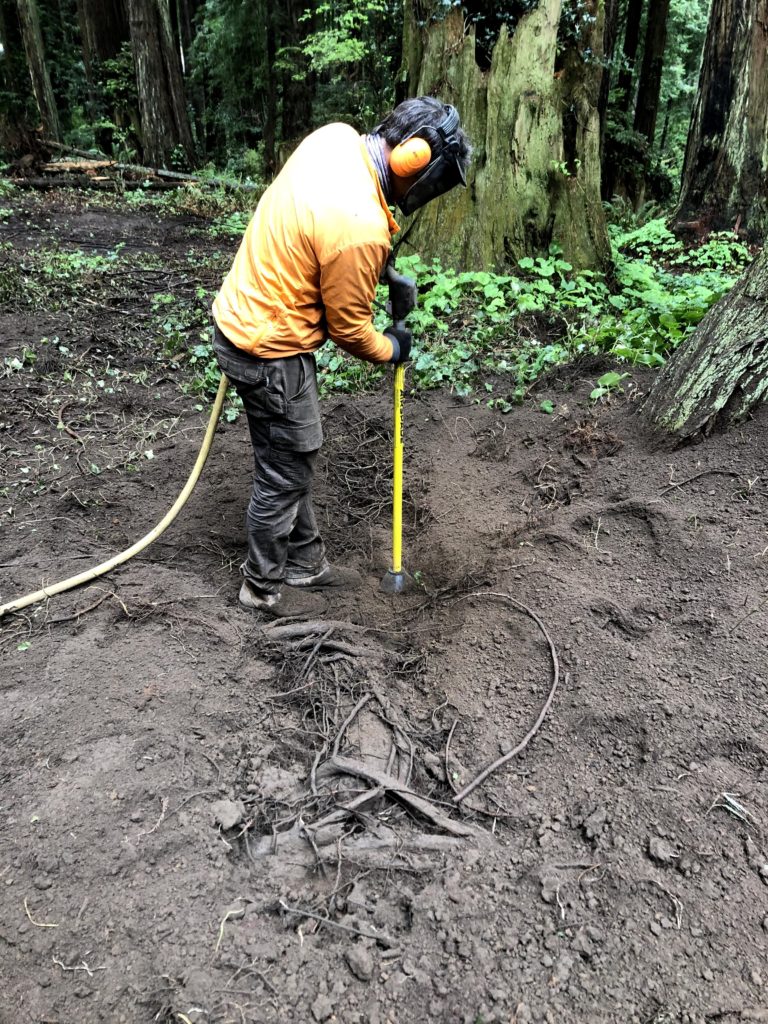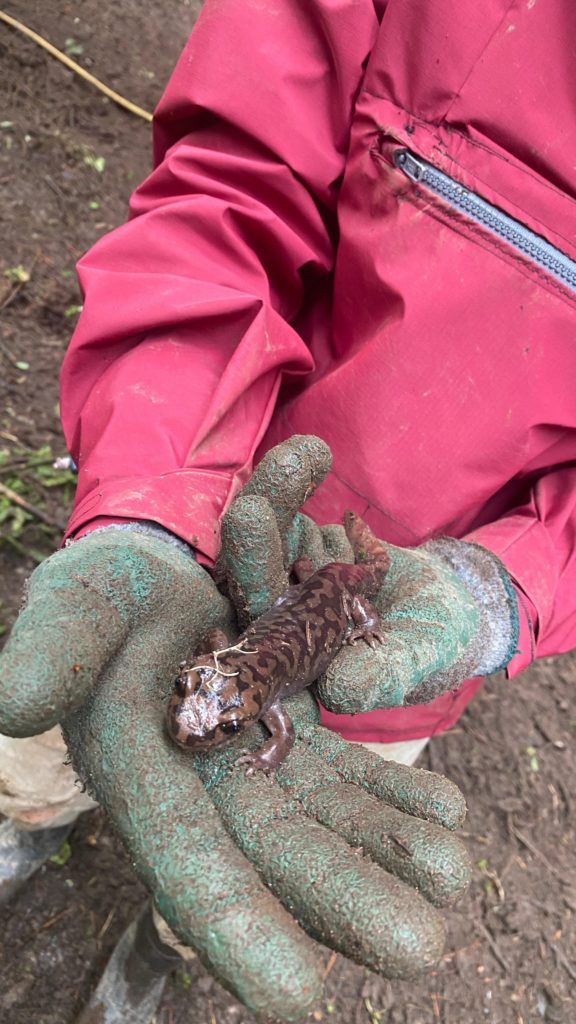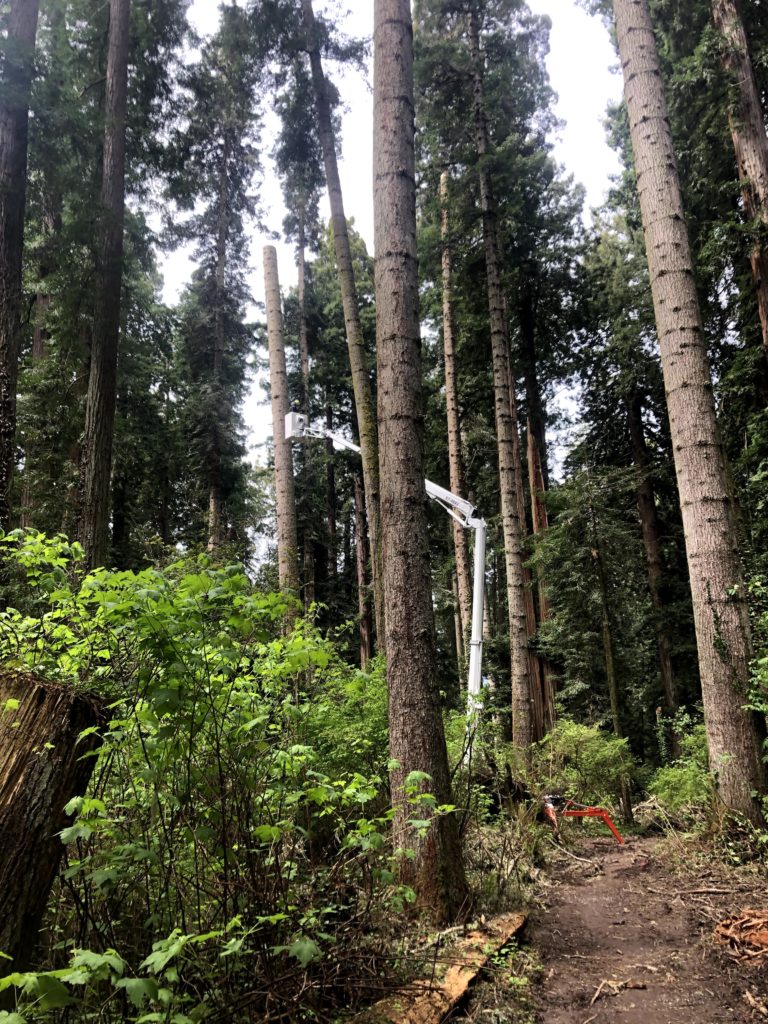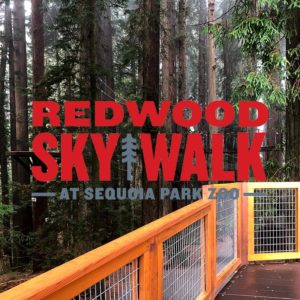As the Redwood Sky Walk moves from the drawing board to opening day, progress on site has begun! Learn more about how we are protecting and enhancing our beloved Sequoia Park forest.
Tree Management and Wildlife Snag Creation
The City of Eureka and the Sequoia Park Zoo are working with arborists and local tree care companies to complete tree management, hazard tree removal, and wildlife snag habitat creation on trees in Sequoia Park. Wildlife snags refer to trees with dead wood features (holes, cracks, loose bark, etc.) that provide food and habitat for cavity dwelling species. This work is necessary to support activities of the Sequoia Park Zoo Master Plan including a Zoo expansion, an improved walking trail behind the Zoo, new animal exhibits, and the Redwood Sky Walk.
The area behind Sequoia Park Zoo has experienced major storm events over the last 20 years that have caused tree failures within the park, and many of those failures involved grand fir. Visitor safety is the number one priority for the City of Eureka and the Zoo. Since these projects will bring more visitors to these areas, several trees required management for everyone’s safety.
The City and our project manager Greenway Partners hired Tree Solutions, Inc. (TSI – Seattle, WA) as consulting arborists for the project. TSI staff, with the help of Jim Campbell-Spickler of Eco-Ascensions Research and Consulting (Arcata, CA), measured and assessed 228 trees within the project area and provided an arborist report with detailed findings and management recommendations, which is being used for tree management throughout the Park.
Hazard Tree Management
The goal of the tree management phase of work is to reduce existing hazard trees to safe heights and to enhance newly created snags by adding features to support wildlife habitat, such as bird holes and bat slits. The trees to be modified in this process were selected based on their health and structural assessments and their proximity to future features including new animal enclosures, new accessible walking trails, and the new Redwood Sky Walk. These trees included:
- To reduce fall potential, a dead redwood snag had live growth removed its top while keeping the snag
- One leaning Sitka spruce was reduced to a safe height
- One Western hemlock was reduced to a safe height
- 11 Grand fir trees were reduced to varying snag heights and enhanced with wildlife features
Coastal Tree Service was selected through a bid process to complete the tree management and wildlife snag creation. Over the course of two weeks their team climbed each tree and reduced hazard tree height from 200 plus feet down to safe snag heights ranging from 25 feet to 60 feet, depending on the level of health or structural defects observed.
Creating Wildlife Snags
Many of the Grand fir snags already have dead wood features such as holes, cracks, and loose bark that provide habitat for cavity dwelling species. Coastal Tree Service is creating more habitat features by “roughing up” the cut tops using a chainsaw to make V-shaped cuts which can be broken even further with hand tools. This “rough top” will collect moisture and organic matter and provide surface area to encourage decay and holes into the trunk for insects, providing crucial food and nesting for native wildlife.
Wildlife Species that Benefit from Woody Habitat Structures
Dead trees are an essential part of forest ecology, and several species of wildlife depend on dead wood as places to feed, and as cover for resting and reproduction. These include woodpeckers, owls, bats, squirrels, salamanders and insects, and many more.
Bird holes form as trunks decay and woodpeckers begin to work on the decaying wood. Bats often use narrow cracks or loose pieces of bark to roost in that occur as a snag deteriorates. To speed this process and support the bird and bat populations in the park, the wildlife snags will include diagonally drilled bored holes and cut-out slits for bat roosts.
Trail Improvements and Invasive Plant Removal
Tree tops and branches removed during the creation of the wildlife snags will be repurposed throughout the Park and Zoo. Some material will be used to close off unofficial, or rogue trails that weave throughout the Park. These informal trails harm trees by increasing compaction around sensitive tree roots and erosion into headwaters of Martin Slough. Other logs will be kept on site and used as habitat enrichment for the new bear exhibit. In addition, arborists identified a lack of decaying wood debris on the floor of the Park. These fallen logs become important habitat for insects and animals on the forest floor, and increase carbon nutrients and sequestration.
Formal, designated trails are receiving attention and rehabilitation with some being rerouted to better protect the sensitive forest floor. With the assistance of the California Conservation Corps, additional measures being taken to improve the overall health of the forest include the removal of invasive plant species such as English ivy, cotoneaster, and holly in particular. These non-native species often outcompete native plants and damage our sensitive redwood forest ecosystem.
The crumbling and uneven asphalt footpath that runs park-side along the Zoo’s back perimeter fence is being rerouted as the footprint of the Zoo expands in preparation for the new bear exhibit. The new and improved path will improve safety with a new surface and will offer a more scenic view of the surrounding forest. Accessibility will be enhanced by connecting Glatt and Madrone Streets with an ADA-compliance pathway. Transition of foot traffic from the old path to the new one is being closely managed to ensure an uninterrupted route for park visitors and regular walkers.
Protecting Tree Health
The bridges and platforms that will allow visitors to traverse the Redwood Sky Walk will be suspended from the trees themselves without any impact to the forest floor below. The technique and mechanics of these attachments have been created by Tree Solutions Inc. of Seattle, WA to ensure minimal impact on the tree, allowing the tree to heal and giving it room to grow unimpeded.
Ascent Ramp Site Prep: Root Health
Getting to the launch deck for the Redwood Sky Walk will follow an ascent ramp through the current barnyard exercise pasture and into the forest. This ascent ramp will be supported by ground posts, some of which will be placed in close proximity to redwoods. In order to protect the trees and their root systems an air spade is being used to conduct root explorations. The air spade is a non-invasive tool that uses pressurized air to safely excavate soil around the base of the tree and allows our team to identify and avoid major root systems. Before and during the excavation process the area is surveyed for sensitive species of plants and animals, with species such as Trillium being transplanted nearby. The team has also found a variety of salamander species during this work, which were safely relocated away from the activity.
Here are some images of successfully created wildlife trees. There are some great wildlife snag examples already in Sequoia Park, too. See if you can spot them!





